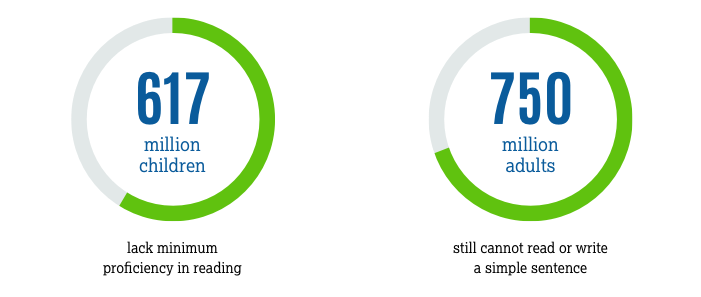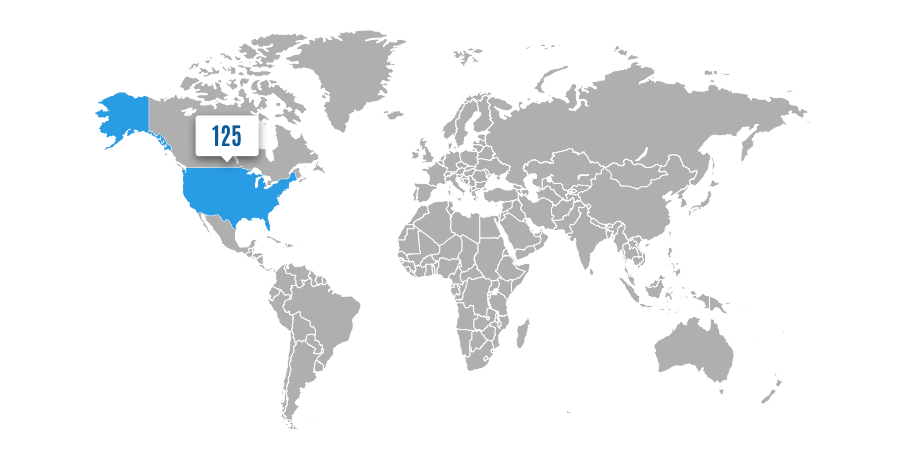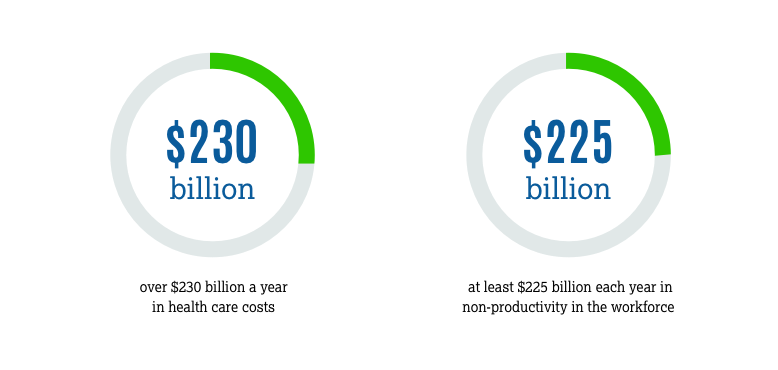Literacy is a bit of a trigger word in today’s landscape. Between Michigan’s Read by 3rd Grade retention law, the emphasis on media literacy, and the challenges of adult illiteracy across the world, some argue it’s a global crisis.
It is true that literacy rates have been trending up over the last 2 decades, going from 83% to 91%. However, according to UNESCO, there are still an estimated 617 million children in primary and lower secondary schools that lack minimum proficiency in reading. What’s more eye-opening is that 750 million adults still cannot read or write a simple sentence.[i]

Even with increased attention from policymakers and the public, literacy trends are predicted to stay stagnant in middle and high-income countries over the next decade. In Francophone African countries, literacy rates are expected to drop by nearly a third by 2030.
And while you might think that the United States is at the forefront of literacy and education, it ranks 125th for literacy rate among all countries.[ii] The reasons for that are quite complex.

The Organization for Economic Cooperation and Development (OECD) is comprised of 35 countries, most of which are from Europe. OECD compiles educational data from nations across the globe.
According to their latest report, the United States was one of only five countries in the OECD to cut education funding in the years leading up to the study. The United States spent approximately $12,800 per student on elementary and secondary education, which is 35% more than the OECD country average.[i]
Where the United States starts to fall behind is how much knowledge students gain from their education. According to the Programme for International Student Assessment, 15-year-olds in the U.S. ranked 31st out of 35 OECD countries in standardized tests.iii
What more countries are starting to realize is that without a solid foundation of literacy skills, students are being set up to fail in all other areas of their education.
The stale educational adage of “learn to read, read to learn” is starting to show its many flaws, one of which is that everyone learns differently.
Without the right educational programs, professional training, development of teachers and resources available to the student, some students are never given a fair chance at a proficient education.
If a student is two grade levels behind in their reading proficiency for multiple years in a row, it is bound to have a trickle down effect into other areas of his education and life.

Illiteracy in America
In the current digital landscape, literacy is more important than ever. Not only being able to read and digest information but being able to critically analyze as well.
According to the American Journal of Public Health, low literacy is said to be connected to over $230 billion a year in health care costs because almost half of Americans cannot read well enough to comprehend health information.[i]
Low literacy also costs the U.S. at least $225 billion each year in non-productivity in the workforce and loss of tax revenue due to unemployment.[ii]

Literacy is so vital in being able to navigate today’s culture that dozens of subcategories have been introduced and taught. Subjects like media literacy, digital literacy, and financial literacy are starting to find the spotlight, and rightly so.
Because literacy permeates so much throughout our daily lives, the psychological and societal impact of being illiterate can be life-altering.
Social Impact: Literacy shapes how we learn, work, and socialize. Because of that, illiteracy often leads to low self-esteem, shamefulness, fear, and the feeling of being excluded. Reading and writing play a pivotal role in decision making, personal development, and community engagement. Individuals with low literacy rates can struggle to know their rights, to work and to pay bills.
Economic Impact: We touched on some of the larger economic impacts that illiteracy has, but the impacts it has on the individual are just as eye-opening. Those with the lowest literacy scores are 1,650% more likely to have received public financial aid.
Generational Impact: Children whose parents have low literacy skills have a 72% chance at reading at the lowest levels themselves. According to the National Bureau of Economic Research, these children are more likely to get poor grades, display behavioral problems, have high absentee rates, repeat school years, or drop out.
In Michigan, where IMSE is headquartered, the state legislature passed a law requiring students more than a grade level behind in reading skills to be held back in third grade.
While a commitment to literacy and education is normally a welcome sign, the tactics of this law have raised some eyebrows. According to a study by Michigan State University, nearly 5,000 third graders would repeat third grade this year.[iii]
While it falls in line with the “learn to read, read to learn” philosophy, many parents and teachers are still wondering if this will be part of the solution or just create more problems.
The truth is there can’t just be one correct way to teach someone literacy skills, and that’s because everyone learns differently.
While it’s encouraging that governments are starting to take notice in broad-stroke procedures and educational resources, the impact isn’t felt as much in the classroom.
The International Association of Literacy conducted a survey of literacy professionals and leaders in over 91 countries. In total, over 2,000 responded.
Of all the topics regarding literacy, professional learning and development was the most important theme among literacy coaches, specialists, and classroom teachers. Other important topics included early literacy, equity in literacy education, and teacher preparation.[i]
By equipping teachers and educators with as many tools as possible, we can help ensure that every student is given the opportunity to learn in a manner that’s best for them.

Literacy Strategies
You might be thinking, “That seems like a lot of information and not a lot of direction.” Congratulations! You’ve just gotten to the heart of the global literacy crisis.
Because education policies are made at a district level, it leaves room for drastically different curriculum and teaching styles across city, state, and country lines.
The effective styles all understand three things:
- The path to literacy is developmental
- Becoming literate is a multi-sensory process where students are active learners
- Students take individual and multiple paths in their learning
By fully understanding these principles, it opens the way for teachers to develop their knowledge of each student’s learning profile and how to track their steps to literacy.
By doing this, teachers and literacy coaches can strategically analyze and use that information to guide students learning. To do this, however, policymakers and school districts need to start looking at teachers as our greatest resources.
Without proper training and development, teachers cannot be expected to live up to the standard of “No Child Left Behind”. In many educational settings, a more fitting motto would be “Better Keep Up”.
In our next series of blogs, we will take an in-depth look at effective literacy strategies and how you can implement them in your classroom.
IMSE believes that all children should be able to read. To achieve this end, IMSE wants to bring Orton-Gillingham to all educators to give children the best literacy instruction possible.
Learn more about what you can do to improve literacy for all using the Institute for Multi-Sensory Education’s Orton-Gillingham training.
Please connect with us on Facebook, Twitter, and Pinterest to get tips and tricks from your peers and us. Read the IMSE Journal to hear success stories from other schools and districts.
[i] United Nations. (2019). Sustainable Development Goals: 2019 Report. (https://www.un.org/sustainabledevelopment/education/)
[ii] World Atlas. (2018, September 14). List of Countries By Literacy Rate. (https://www.worldatlas.com/articles/the-highest-literacy-rates-in-the-world.html)
[i] American Journal of Public Health. (2010). Health Literacy: Confronting a National Public Health Problem. (https://www.apha.org/policies-and-advocacy/public-health-policy-statements/policy-database/2014/07/09/08/00/health-literacy-confronting-a-national-public-health-problem)
[ii] National Council for Adult Learning. (2015). Adult Education Facts That Demand Priority Attention. (http://www.ncalamerica.org/AdultEDFacts&Figures1215.pdf)
[iii] Michigan Radio. (2019). Michigan Reading law would hold back almost 5,000 third graders if took effect today. (https://www.michiganradio.org/post/michigan-reading-law-would-hold-back-almost-5000-third-graders-if-took-effect-today)
[i] Organization for Economic Cooperation and Development. (2018) Education at a Glance 2018: OECD Indicators. (http://www.cnedu.pt/content/noticias/internacional/Education_at_a_glance_2018.pdf)
[i] International Literacy Association. (2018). What’s Hot in Literacy Report. (https://www.literacyworldwide.org/docs/default-source/resource-documents/whats-hot-2018-report.pdf)
